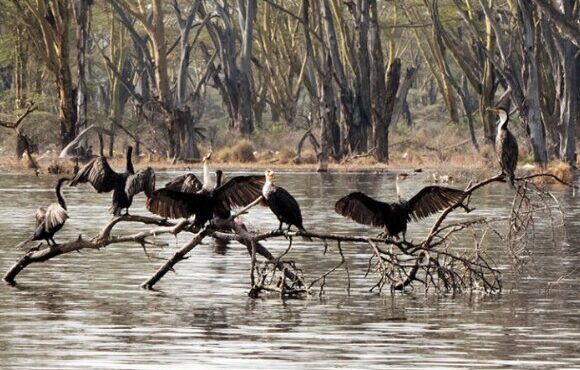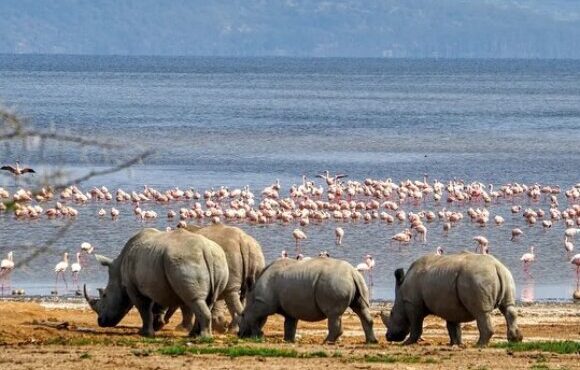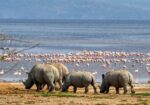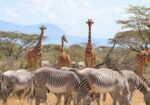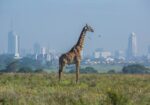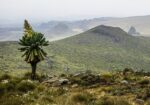Overview
Lake Nakuru National Park is among Kenya’s premier safari destinations, celebrated globally as a haven for bird enthusiasts. At its heart lies Lake Nakuru, a vast, shallow alkaline lake lying on the floor of the Great Rift Valley. The park’s landscape is a captivating mix of cliff-lined rocky escarpments, plains of bushy grasslands, and scattered acacia woodlands. This diverse environment provides a sanctuary for a remarkable variety of bird species and wildlife.
The park gained global fame for the countless pink flamingos that once lined the shores of Lake Nakuru, creating a breathtaking spectacle. However, the lake’s water levels are prone to fluctuation. In recent years, a significant rise in water levels prompted the flamingos to migrate to other lakes within Kenya’s Great Rift Valley Lake System. Today, the lake is eerily surrounded by drowned trees, but the abundance of other bird species continues to enhance the park’s appeal.
Attractions of Lake Nakuru National Park
Wildlife
Under favorable conditions, Lake Nakuru can host up to 2 million lesser flamingos foraging along its shores, creating a spectacular display of pink. The lake’s alkaline water, rich in salts, provides an ideal habitat for blue-green algae and tiny crustaceans, which form the key food source for the flamingos. The algae not only sustain the birds but also contribute to their iconic pink coloration. The number of flamingos present at any time varies, depending on the lake’s water levels and salt concentration.
Lake Nakuru National Park is a birdwatcher’s paradise, home to over 450 bird species, including its famous flamingos. Among the notable water birds are the great white pelican, yellow-billed stork, marabou stork, grey heron, and hamerkop. The grasslands and woodland forests host species such as the ostrich, helmeted guinea fowl, crowned lapwing, yellow-throated longclaw, red-cheeked cordon-bleu, speckled mousebird, white-browed robin-chat, Rüppell’s long-tailed starling, and African hoopoe.
Birds of prey are also well-represented, with species like the African fish eagle, martial eagle, augur buzzard, and Verreaux’s eagle-owl. During the rainy season, migratory birds flock to Lake Nakuru, including the common greenshank, wood sandpiper, black-winged stilt, ruff, northern shoveler, garganey, Eurasian teal, white stork, steppe eagle, and Montagu’s harrier.
Exploring beyond the lake unveils a diverse array of forest dwellers and plains game. Lake Nakuru is home to 56 mammal species, including Thomson’s and Grant’s gazelles, impalas, reedbucks, warthogs, buffalo, zebras, both black and white rhinos, and Rothschild’s giraffes.
The park also supports an array of carnivores and smaller mammals, such as lions, leopards, spotted and striped hyenas, silver-backed and side-striped jackals, servals, civets, genets, and mongooses. Among the primates, olive baboons are the most prominent, while the elusive black-faced vervet monkeys and the playful colobus monkeys often leap gracefully amongst the trees.
Pythons inhabit the forest and are sometimes spotted coiled in tree branches or, with some luck, in the act of swallowing prey whole. In the marshes and swamps, visitors may encounter hippos, waterbucks, and the African clawless otter, adding to the park’s incredible biodiversity.
Scenic Highlights
Lake Nakuru National Park boasts a diverse topography enriched by approximately 550 plant species that contribute to its ecological significance and visual appeal. At its core lies Lake Nakuru, a vast, shallow, semi-alkaline lake bordered by swamps that sustain abundant wealth of wildlife.
The park is surrounded by escarpments and hills blanketed with bushlands, offering excellent vantage points with breathtaking views of the lake and its surroundings. Open grasslands dominate the lower plains around the lake, complemented by dense woodlands primarily composed of acacia and euphorbia species.
On the park’s southern boundary, rocky ridges and cliffs add a dramatic element to the landscape. Seasonal rivers and features like the Makalia Waterfalls further amplifies the park’s scenic charm, making it a must-visit destination for nature enthusiasts.
Activities & Experiences in Lake Nakuru National Park
Game Drives
Visitors can explore Lake Nakuru National Park on guided game drives in 4×4 vehicles equipped with pop-top roofs for optimal wildlife viewing. Spanning an area of 180 sq. km, the park’s relatively small size makes it easier to navigate and explore.
Game drives are typically scheduled for early morning and late afternoon when animals are most active due to cooler temperatures. During the hotter midday hours, many animals rest to escape the sun, making sightings less frequent. For a more immersive experience, full-day game drives can also be arranged.
Bird Watching
For bird enthusiasts, Lake Nakuru National Park offers exceptional bird watching opportunities, with over 450 bird species thriving across its diverse habitats.
Guided Nature Walks
Walking safaris provide an intimate and unique opportunity to experience the African wilderness of Lake Nakuru National Park. A highlight of these walks is Baboon Cliff, a popular viewpoint that offers spectacular views of the lake. This spot is also home to family groups of baboons, where visitors can enjoy watching the playful antics of their young.
The Out of Africa Lookout is renowned for rewarding visitors with the best panoramic views of the park. Although it is less frequented due to its steeper climb, the effort is well worth it. This vantage point provides breathtaking, sweeping vistas and serves as an ideal spot for sundowners, adding to the overall experience.
Photography
In addition, Lake Nakuru National Park provides unforgettable visual experiences, making it a paradise for photography enthusiasts. Its breathtaking scenery and abundant wildlife provide countless opportunities to capture stunning moments. The park’s picturesque landscapes, combined with its diverse terrain, create the perfect backdrop for wildlife photography.
Conservation and Sustainability in Lake Nakuru
Large herds of rhinos once roamed vast areas of Africa, but poaching and habitat loss have severely diminished their numbers, rendering them endangered. Lake Nakuru National Park stands as one of Kenya’s most successful rhino conservation initiatives, providing a secure sanctuary for both black and white rhinos. These magnificent animals are a major attraction and one of the key reasons the park is fenced for their protection.
The park also serves as an important refuge for the Rothschild’s giraffe, one of the most endangered and distinct giraffe subspecies. The population here is particularly unique, as it descends from individuals rescued from western Kenya in the late 1970s due to habitat loss and successfully relocated to the safety of Nakuru.
Wildlife conservation enthusiasts visiting the park have the unique opportunity to learn about its significant role in conservation and sustainability efforts, making it an inspiring destination for nature lovers and advocates.
Best Time to Visit Lake Nakuru
Lake Nakuru is a year-round destination, offering unique experiences in both the wet and dry seasons. Unlike many other parks, wildlife watching remains excellent even during the wet season. This is because the park’s small size and surrounding fence ensure that animals remain concentrated within its boundaries.
- Dry Season (June to October, January and February): During this period, water sources shrink, making it easier to spot birds of prey and water birds congregating near the lake.
- Rainy Season (March to May and October to December): This season brings migratory birds, increasing avian diversity and creating excellent birdwatching opportunities. The park also features lush green landscapes and experiences fewer crowds, enhancing the overall visitor experience.
Where to Stay in Lake Nakuru National Park
Several world-class accommodation options are available at Lake Nakuru National Park to suit different preferences and budgets. Visitors can choose from basic, budget-friendly campsites, perfect for those seeking affordable stays, to luxurious lodges and upscale tented camps that cater to more discerning guests looking for premium comfort and amenities.
How to Get to Lake Nakuru National Park
Lake Nakuru National Park is located in Nakuru County, just 4 kilometers from Nakuru town, the county’s capital and the main gateway to the park. The park lies approximately 156 kilometers northwest of Nairobi, Kenya’s capital city, and is easily accessible by both air and road.
By Air: Several domestic airlines, including Air Kenya and Safarilink, operate charter flights from Wilson Airport in Nairobi, Kenya’s capital, to Naishi Airstrip in Nakuru. The flight takes approximately 30 minutes and offers stunning aerial views of the Great Rift Valley, making it the fastest and most convenient mode of travel. Upon arrival at Naishi Airstrip, prearranged safari vehicles are available to transport visitors to the park or their chosen accommodations.
By Road: Traveling from Nairobi to Nakuru by road covers a distance of approximately 156 km and takes about 3 to 4 hours via the Nairobi-Nakuru Highway. The well-paved route passes through the stunning landscapes of the Great Rift Valley, with opportunities for brief stops to enjoy the scenery along the way. Once in Nakuru, the park can be accessed through the Main Gate, situated just 4 km from Nakuru city, or via the Lanet Gate and Nderit Gate.
Lake Nakuru National Park Safari Packages
Lake Nakuru National Park is an excellent choice for travelers seeking a compact, wildlife-rich safari experience known for exceptional birdlife, iconic rhino sightings, and striking landscapes. Safari packages range from short, park-focused visits to extended multi-destination itineraries that combine Lake Nakuru with other premier parks such as Lake Naivasha, the Masai Mara, Amboseli, Samburu, or even Kenya’s coastal beach resorts. These packages accommodate solo travelers, couples, families, and groups, offering flexible options tailored to different interests, durations, and budgets.
Unlike the vast open plains of destinations such as Masai Mara, Lake Nakuru provides a concentrated safari environment where wildlife viewing is highly reliable due to the park’s compact size and fenced boundaries. Guests enjoy diverse experiences, from observing flamingos along the alkaline lake shores to spotting endangered black and white rhinos, Rothschild’s giraffes, and abundant bird species. Whether planning a short day trip, an overnight stay, or incorporating Lake Nakuru into a broader Kenyan safari circuit, it can be seamlessly integrated into a personalized and memorable itinerary.
Conclusion: Why Visit Lake Nakuru National Park
Lake Nakuru National Park is renowned worldwide as a birdwatcher’s paradise, boasting over 450 bird species and gaining fame for the vibrant pink flamingos that grace its shores whenever conditions are favorable. The park is a visual gem, centered around Lake Nakuru—a vast, shallow, alkaline lake—surrounded by rugged escarpments, bushy grasslands, and pockets of acacia woodlands, all contributing to its stunning beauty.
In addition to its easily observable and diverse wildlife, the park is a hub for conservation, playing a vital role in protecting endangered species such as black and white rhinos and the Rothschild’s giraffe. Visitors have the chance to learn about and support these critical efforts.
With its convenient accessibility and a wide range of activities—including game drives, birdwatching, guided nature walks, and photography—Lake Nakuru National Park offers an unforgettable safari experience. It is truly a must-visit destination on any Kenyan safari itinerary.
Planning Your Lake Nakuru Safari in Kenya? Start Here!
At Giorgi Safaris, we specialize in tailor-made Kenya safari holidays crafted to match your interests, schedule, and travel style. Our packages include expert safari guides, reliable 4×4 vehicles with pop-up roofs for optimal game viewing, and thoughtfully designed itineraries that showcase the very best of each destination.
We partner with trusted lodges and camps to ensure your experience is smooth, enjoyable, and truly unforgettable from the moment you arrive to the moment you leave.
Contact Giorgi Safaris today to book your safari or request a custom itinerary tailored to your travel goals. We’re here to help you make the most of your time in one of Kenya’s most iconic and accessible wildlife destinations.

